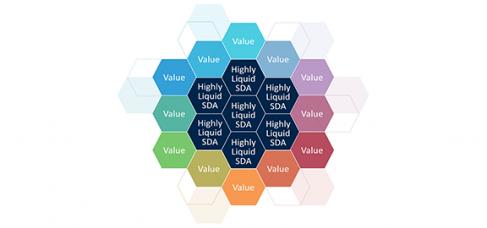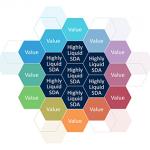MIT CISR data sharing research shows that top-performing organizations’ internal data sharing is significantly more advanced than that of bottom performers.[foot] Based on findings from the 2022 Internal Data Sharing Survey (n=604). The survey was issued by lead author Dr. Randy Bradley, funded through the Advanced Supply Chain Collaborative (ASCC), which is an initiative of the Global Supply Chain Institute (GSCI) in the Haslam College of Business at The University of Tennessee—Knoxville (UTK). The authors of this briefing trimmed the data set for MIT CISR’s analysis to specify respondents with a job level of manager or above and work experience of 6+ years, from companies with >1,000 employees and revenues ≥US$500 million. In the resulting sample (n=137), which was slanted slightly toward more senior respondents from organizations operating outside North America, top-performing organizations reported significantly higher levels of internal data sharing (p<.05) than bottom-performing organizations.[/foot] Internal data sharing—the ability to easily exchange data assets enterprise-wide—allows organizations to cost-effectively meet informational needs from new business threats and opportunities. This ability generates payback in the form of greater data monetization returns and a lower cost to serve data assets to the organization’s data consumers.
Emergent business threats and opportunities require new information for all kinds of reasons. Consider the influx of opportunities that arise as part of the advancement of AI. As organizations pursue AI opportunities, their AI teams increasingly need novel and cross-domain data. For example, AI models that predict operational failures require data about past incidents, but their predictions are more accurate if they also include weather, people, equipment, and usage data. Similarly, models that classify customers into segments require sales history, but they classify more usefully if they additionally leverage data about demographics, preferences, and online behaviors. When data is owned and managed in organizational pockets it is less accessible, and AI projects relying on the data slow down and become more costly.
Using case examples from Amcor, FEMSA, Fidelity Investments, and Scentre Group,[foot] In Q1 2023, to create case examples illustrating insights from this research, the authors of this briefing conducted four interviews with a total five executives from Scentre Group, FEMSA, Amcor, and Fidelity Investments. All were members of the MIT CISR Data Research Advisory Board, a community of data and analytics leaders from MIT CISR member organizations who participate in and inform MIT CISR research.[/foot] this briefing illustrates how organizations can achieve advanced internal data sharing.












